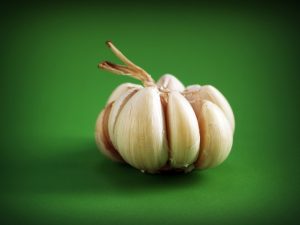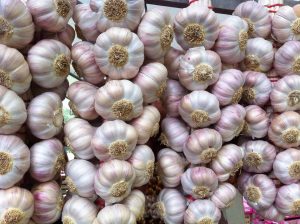Growing Garlic
 by Matt Cogger, Bayfield/Ashland County UW-Ext Horticulture Agent
by Matt Cogger, Bayfield/Ashland County UW-Ext Horticulture Agent
Garlic is one of the few horticultural crops that is planted in the fall in Wisconsin. The reason for this is that the cloves need to be exposed to cool temperatures for next year’s growth to form bulbs. Wild relatives of garlic can still be found in Central Asia. It is likely that the original range was much larger since there is evidence of garlic production in Egypt and India 5,000 years ago. Like other alliums garlic stores energy in modified leaves. Having been to Kyrgyzstan in Central Asia it seems that garlic is very well adapted to the climate. The bulbs act as a storage structure for the plant to survive winter. In the spring and early summer when rain is more prevalent the plants come out of dormancy and begin forming bulbs for next year. Late summer and early fall in Kyrgyzstan tend to be drier and this is when the plants reach maturity and begin to go dormant in preparation for winter.
Garlic is often grouped into three classes, hardneck, softneck, and elephant garlic. The classification of garlic can seem arbitrary. Elephant garlic is actually more closely related to leeks than garlic. The classification of hardneck and softneck garlic is based on the stem at harvest. As the name implies the stems of hardneck garlic stay rigid and softneck do not. The growth habit of garlic can change depending on the location it is grown in. Sometimes hardneck varieties will grow more like softneck garlic and vice versa.
Like many crops that produce bulbs garlic grows best in well-drained soil. Avoid planting in areas where water accumulates in the fall and spring. Make sure to select a garlic variety that is suited to our hardiness zone. Bayfield and Ashland counties have USDA hardiness zones that range from 3b to 5a. Many seed catalogues will have a hardiness zone map or you can visit http://hort.extension.wisc.edu/maps/ to find your hardiness zone. When growing garlic for the first time buy bulbs produced specifically for propagation.
In our area garlic should be planted about six to eight weeks before the ground freezes. The time of freezing varies depending on the year but it usually seems that the ground tends to freeze around the time of deer season and Thanksgiving in late November. Working backwards this leaves a planting date in late September or early October.
To plant garlic break apart the bulbs and plant the individual cloves two inches deep about four inches apart with the tips facing up. Garlic is usually grown in double or triple rows with a two or three-foot spacing between the rows. Mulch the planting with three to four inches of straw. The purpose of the straw is to prevent the ground from thawing then re-freezing during warm days.
For more information contact:
Matt Cogger
Agriculture and Horticulture Agent
Bayfield County – UW Extension
County Administration Bldg
117 E. 5th Street
Washburn, WI 54891-9464
Phone: 715-373-6104, Ext. 246
Fax: 715-373-6304
Email: mcogger@bayfieldcounty.org
711 for Wisconsin Relay (TDD)





